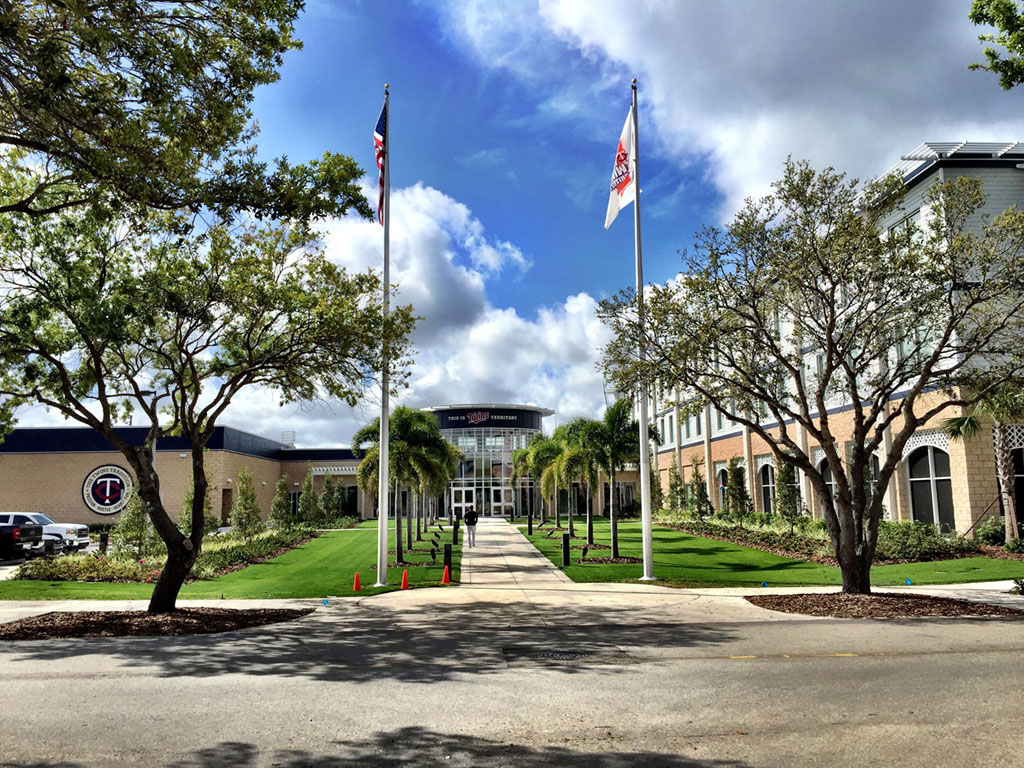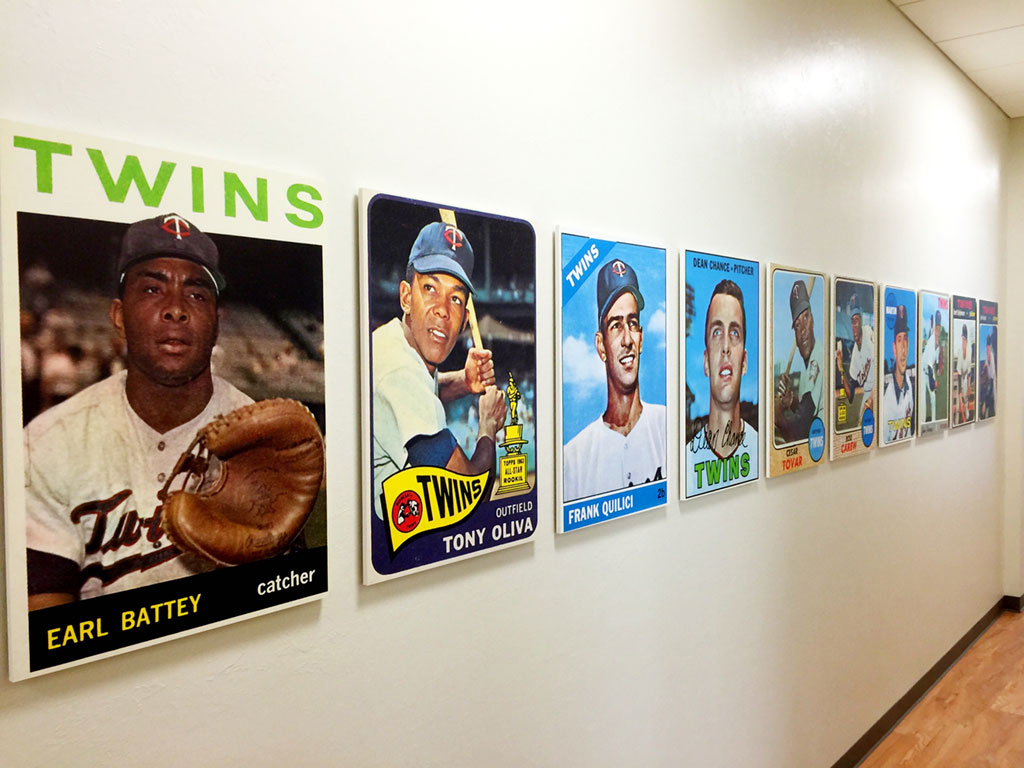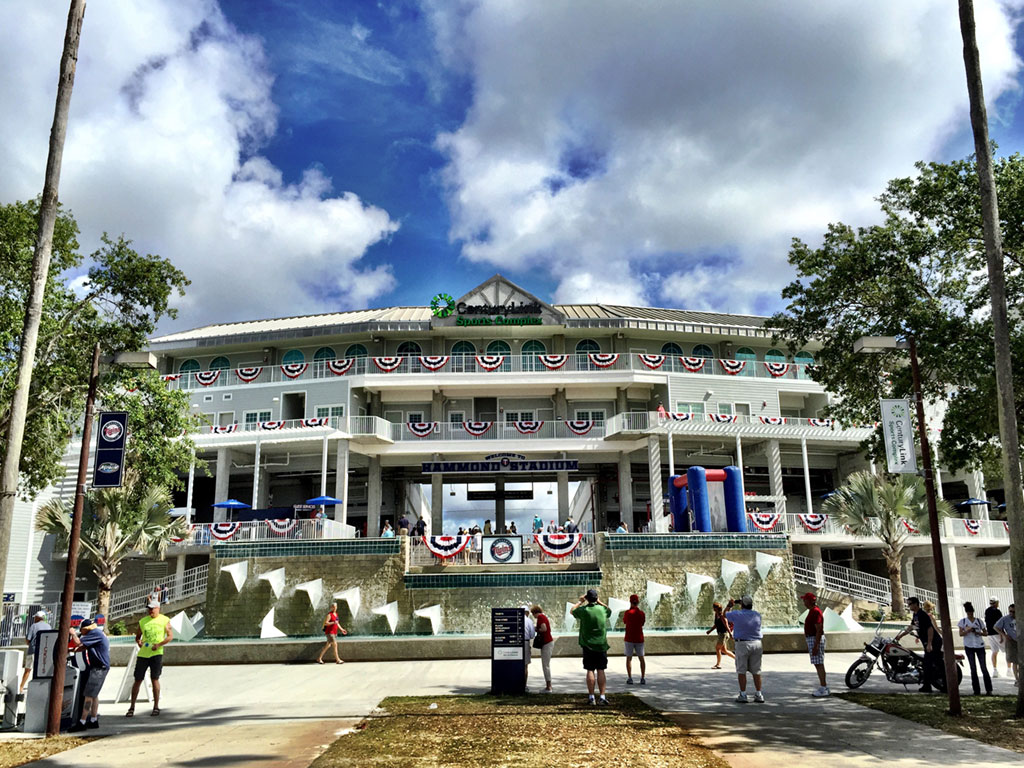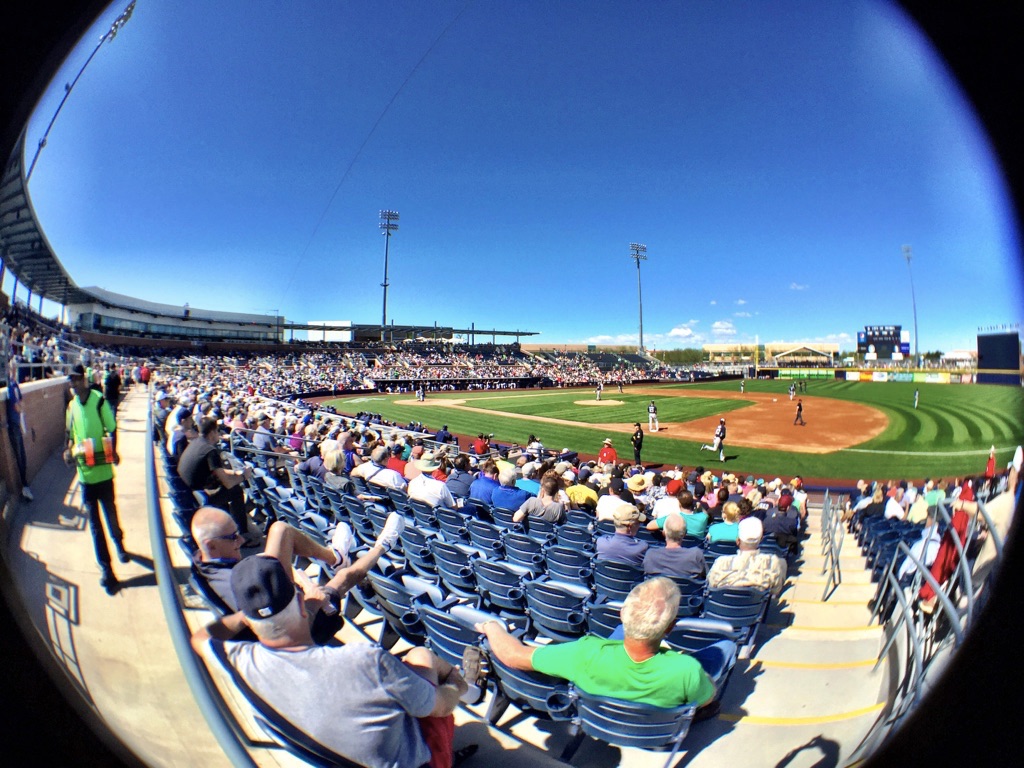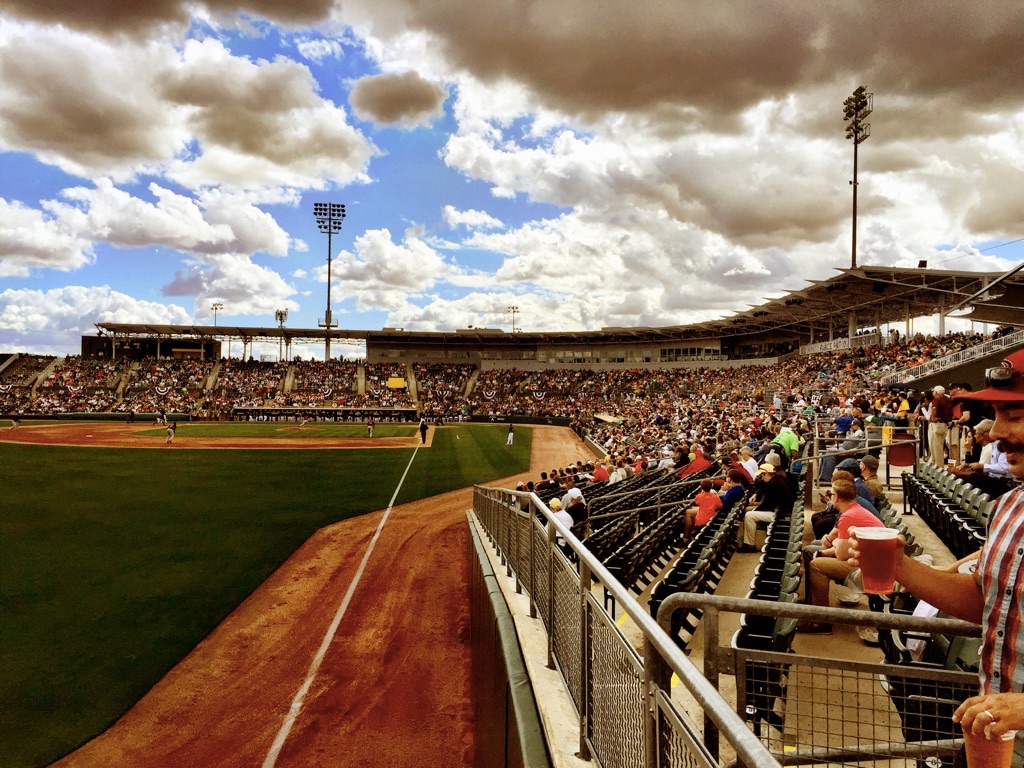It was a two-year project, an extreme makeover designed to keep spring-training, regular-season and developmental operations running while the CenturyLink Sports Complex and Hammond Stadium were renovated and expanded — a project that earned Ballpark Digest’s Best Major Ballpark Renovation of 2015.
CenturyLink Sports Complex and Hammond Stadium serve many needs. The complex is the spring-training home of the Minnesota Twins and the center of the team’s year-round player development. In addition to hosting Twins spring games, Hammond Stadium is the regular-season home of the Fort Myers Miracle (High A; Florida State League).
“Most Twins fans are very familiar with the Lee County Sports Complex and Hammond Stadium as the team’s spring-training home,” said Kevin Reichard, Ballpark Digest publisher. “But the newly named CenturyLink Sports Complex and Hammond Stadium are designed to do so much more: the ballpark also served as the regular-season home of the Fort Myers Miracle, and the complex is used year-round to develop the next generation of Twins players. With a new state-of-the-art player development academy, the Twins and their partners have created a facility that is a model for other MLB teams planning their developmental roadmap.”
The two-year, $48.5-million renovation was funded via a public-private partnership between the Twins and Lee County, which used tourist-development tax dollars on the project. The design came from Populous, the Kansas City (Mo.) sports-architecture firm also responsible for the Target Field design, while construction was overseen by Manhattan Twins Joint Venture, a partnership between Manhattan Construction Company, Chris-Tel Construction and Casey Construction.
For fans, the biggest change in the 2014-2015 CenturyLink Sports Complex renovations was the overhaul of Hammond Stadium. The renovations, which were unveiled in Spring Training 2015, took the bones of what was already a decent ballpark and added a 360-degree concourse, upgraded seating options, outfield bars, expanded concourses, improved restrooms, a new retail store, and more. The renovations benefited the Twins at spring training, but they also benefited the Florida State League’s Fort Myers Miracle as well: the team set both single-game and season attendance records in 2015.
But some of the more groundbreaking improvements are behind the scenes and won’t ever be seen by fans. Chief among them: a state-of-the-art player development academy (shown above). While player acquisition these days now a global effort, MLB teams draft and sign many players from the Caribbean and South America. For these young men, transitioning to professional baseball and America can be a wrenching experience. The Twins, who partially funded the $6-million construction cost, are calling it a player development academy, but it wouldn’t look out of place on most college campuses. With a modern design featuring dorm-like housing built around a courtyard, a group multimedia/game area (complete with big-screen TVs, game consoles, domino tables, and more), conference rooms named for Twins greats, 24-hour security, and a large cafeteria with the capacity to feed 150 players and coaches.
“The Twins have enjoyed a model partnership with Lee County since moving to SW Florida in 1991,” Twins President Dave St. Peter said. “We are incredibly proud of the CenturyLink Sports Complex renovation project and the results it delivers each and every day for our players, staff, fans and citizens of Lee County.”
“We wanted to create the best baseball experience for our residents and the spring training fans who visit Lee County,” said Brian Hamman, Chairman, Lee County Board of County Commissioners. “The results of this renovation have exceeded our expectations. Not only are we setting an example for the nation when it comes to spring training, but we’re driving millions of dollars into our economy by creating an amazing venue for sports tourism.”
“The Fort Myers Miracle are grateful to call the CenturyLink Sports Complex home for twenty-five years,” said Jason Hochberg, President of SJS Beacon Baseball and principal owner of the Fort Myers Miracle. “The renovations have made the ballpark one of the best spring training and minor league baseball complexes in all of baseball. We would like to thank Lee County, the Twins and all of the contractors for their efforts.”
“The Minnesota Twins and Lee County aspire to excellence and the renovations to CenturyLink Sports Complex ensure an excellent fan experience and baseball training experience for decades to come. From start to finish, the team involved – from the Twins to Lee County to Manhattan Construction – had a vision for creating the best spring training experience for fans and athletes in the nation,” said Bruce Miller, Senior Principal at Populous. “It’s safe to say that was accomplished. The renovated CenturyLink Sports Complex is now a model for Major League Baseball spring training and player development facilities.”
“This best major ballpark renovation designation is a fitting recognition of Lee County community’s vision, The Twins’ player-development leadership, and Populous’ design innovation,” said Bob Bowen, senior vice president at Manhattan Construction. “We are excited for Lee County families who will enjoy events at the ballpark and the memorable moments they will share there. It is an honor to have played a part in renovating this ballpark, which will be a lasting positive influence in this community for generations to come.”
“Player development is such an important activity for MLB teams,” Reichard added. “CenturyLink Sports Complex is a model for MLB and their development needs, while Hammond Stadium is a hit with fans throughout the entire baseball season.”
This was a great year for ballpark renovations of all sorts. Our two previous awards to AutoZone Park and Dr Pepper Ballpark were indicative of the high level of ballpark renovations this season. There are other 2015 ballpark renovations worth noting:
The first phase of Wrigley Field renovations came online this season, as the 1060 Project saw a rebuilding of the outfield bleachers, concourse enhancements and videoboard installations. The project impacted the 2015 season, but it’s certainly an ongoing process: the renovations won’t be completed until 2019.
The Cleveland Indians overhauled Progressive Field’s outfield entrance and right-field area, with a new Gate C providing a dramatic entrance to the ballpark and an upgraded right-field district with new restaurants, bars and kids’ area. This, too, is a two-year process: more changes are on the way for 2016.
Peoria Stadium (shown above) opened this spring with a second round of improvements, with $6 million invested into seating enhancements, façade improvements, expanded entry and plaza area, and upgrades to field and lighting systems. The spring home of the San Diego Padres and Seattle Mariners has always been a popular destination for Cactus League fans; more enhancements are on the agenda for 2016.
Wade Stadium, the historic home of the Duluth Huskies (summer collegiate; Northwoods League), saw the installation of a new playing field, an upgraded left-field entry area and changes to the outfield wall. The WPA-funded facility is a classic in the ballpark world, and the upgrades led to success at the box office for the Huskies.
Another historic facility, Athletic Park is in the midst of a two-year renovation process, as the home of the Wisconsin Woodchucks (summer collegiate; Northwoods League) saw new theater-style grandstand seating, new luxury boxes and upgraded concessions for 2015 and will include a new full-service concession stand, a new group outing area and restrooms, and a complete renovation of the bleacher seating for 2016. A Civilian Conservation Corps-funded and constructed facility that was once a longtime home to Midwest League and Wisconsin State League baseball (John Henry Moss, of all people, ran a Tigers farm team out of this ballpark for three seasons) after opening in 1936, Athletic Park been the home to Northwoods League baseball since the circuit was founded.
And, finally, Hohokam Stadium reopened, this time as the spring home of the Oakland Athletics, after a $20-million offseason renovation that saw a new entry gate, new murals in the concourse, new fan decks, upgraded concessions and the largest LED videoboard in spring training. (It’s shown above.) For players, an expanded clubhouse with weight room provides more comfort than experienced at Phoenix Municipal Stadium. And then there’s the Lew Wolff Training Center at Fitch Park (as we discussed here), which raising Athletics training abilities to a new level.
PREVIOUS 2015 AWARD WINNERS:
Best Ballpark Renovation (Over $6M, Under $20M): AutoZone Park
Best Ballpark Renovation (Under $6M): Dr Pepper Ballpark
Best New Food Item: Sweenie Donut Dog
Broadcaster of the Year: Josh Whetzel
Best New Logos/Branding: Daytona Tortugas
Best New Ballpark: CHS Field, home of the St. Paul Saints


